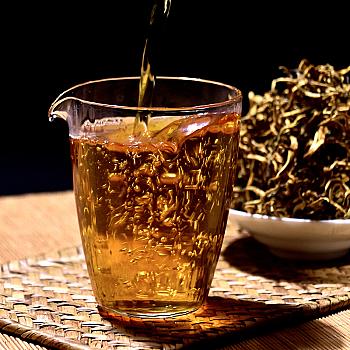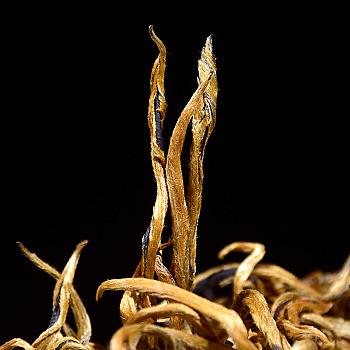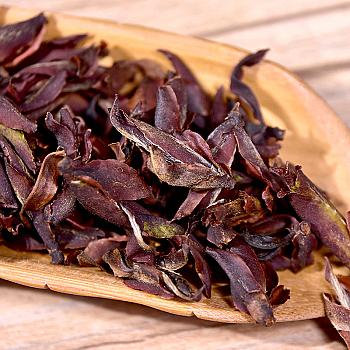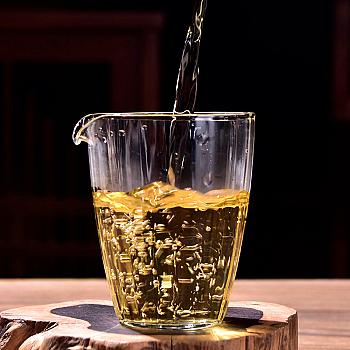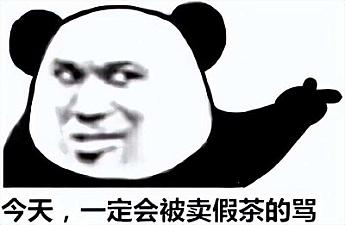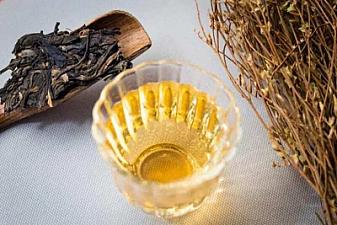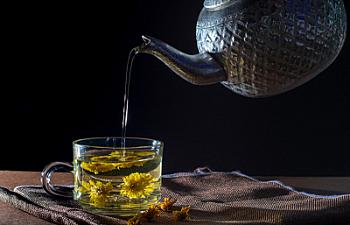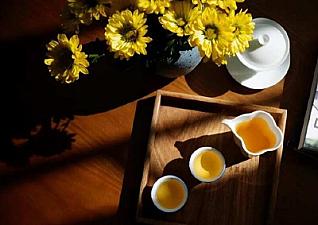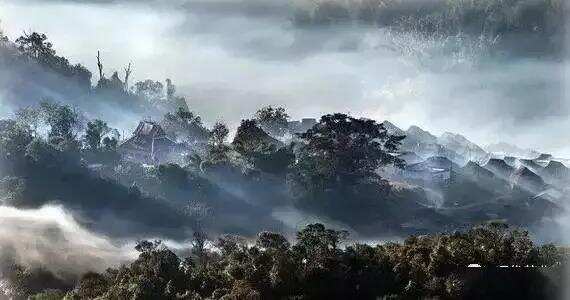
How to choose Puer tea from Yunnan mountain tea? ( Characteristics of Yunnan mountain tea in Puer)
August 16, 2025
The tea varieties of the six main tea regions, namely Dali, Ban Zhang, Nannuo, Pasha, Mengsong and Bada, are collectively called Shan Tuo Cha.
Yunnan Gold Tea, literally meaning tea from the big peaks in Yunnan, refers to the six main tea-producing regions in Yunnan Province: Dian Hong (Large Leaf Golden Tip), Bada (Big White), Meng Song, Pu Erh, Menghai, and Xiao Guang Sheng.

Yixi Tea District
1. External characteristics: Yixing is a tea town, and the history of planting tea in Yixing is old, and there has been a saying that Pan Zhong was king and Yixing was his back garden. Yixing tea, when viewed from leaf strips, leaves are large, buds are small, stems are thick and long, and new tea appears as dark green, pale blue-green yellow. Most of the ancient trees in Yixing have been artificially dwarfed, with thick trunks but not high, and tree shapes are not big, many of them scattered and planted in the mountains and wilds, good ecological environment is one of the reasons for forming the quality of Yixing tea.
2、Characteristics of taste: Easy Wuyi tea is famous for its "softness", especially in the Mahei area, which fully inherits the characteristics of Fragrant Ripples Water Soft. The pure genuine ancient tree tea from the Wuyi region has a transparent and bright yellow soup color, very low bitterness and astringency when drinking, extremely high sweetness, a very fine and smooth texture, soft and gentle water route, with floral fragrance and honey fragrance, if stored for more than one or two years, the floral fragrance will be relatively light, and the honey fragrance will become prominent.
Eyiwa Tea Mountain is located in the southeastern part of the Six Great Tea Mountains, adjacent to the China-Laos border. It has an area of about 750 square kilometres, making it the largest tea mountain among the six. Eyiwa Tea Mountain covers Eiwa Peak, Ma Sa Tea Mountain, and Manal Tea Mountain.

Ban Zhang Tea District
1. This tea is a standard big-leaf variety, so the leaves are thick and robust with plenty of downy hairs on the buds. It has an intense wild forest aroma that's distinct from other teas. The scent is reminiscent of orchid fragrance and honey-like sweetness, but I personally think it's a light cedar note.
2. Puer tea in Ban Zhang Tea Area of Ban Zhang and Nuo Ethnic Minority Autonomous County has the following characteristics: * Thick tea soup * Rich, smooth flavor * Low acidity
Lao Ban Zhang is a Hani ethnic village at an altitude of 1,700 meters, belonging to the subtropical plateau monsoon climate. The region has abundant rainfall and fertile soil, with a good ecological environment. There are more than 4,400 mu of old tea gardens, which are standard big-leaf varieties of Pu'er tea.

The new factory is about 7 kilometers away from the old one, with an average elevation of 1600 meters. All villagers have been relocated to the old one. The taste of the new tea is similar but slightly different from the old one, which has a long-lasting aroma that lingers in the mouth.
Old Mengga is an ancient village of the Bola tribe, with a history dating back more than 1370 years. Its elevation is slightly lower than old Bangzhang, approximately 1300-1400 meters above sea level. There are over 3,000 mu of ancient tea gardens and many ancient trees, whose ages exceed 500 years. The tea produced in Old Mengga is famous for its bitterness, though the bitter taste fades quickly and leaves a sweet aftertaste. The mouthfeel has a special "bitter-sweet" experience.
Baka Zong is a village of the Lahu people, at an elevation of about 1,650 meters (5,400 ft), with over 1,000 mu of ancient tea gardens and tea trees aged more than 200 years apart. The big tea trees of Baka Zong are mostly sweet tea, and its flavor characteristics are mainly smooth, sweet as sugar, clear and refreshing.
Ba Ka Cong is also a Lisu village, with an average elevation of around 1800 meters. The annual temperature is 18.7 degrees Celsius. The ecosystem is well protected and the soil is rich in organic matter. There is sufficient sunlight and rainfall, suitable temperature and humidity, as well as foggy weather throughout the year, providing special climatic conditions for tea cultivation. The tea has a richer internal quality, stronger aroma, and a more profound taste.
The most representative type in Ban Zhang tea area is the old Ban Zhang. Old Ban Zhang is a standard big-leaf variety tea, with thick stalks, plump buds and much more downy hairs, few other teas from this region have such thick stalks and large buds as the old Ban Zhang. The natural environment of old Ban Zhang is good, the tree age is long, there is strong wild mountain scent, and the aroma of loose tea and tea cakes has very distinctive ancient tree fragrance, the aroma type seems to be between orchid and honey fragrances.
Nandu and Pasha
The Pasakha Tea Mountain is located in the west of Gangranghe Township, Menghai County, Xishuangbanna Dai Autonomous Prefecture. The highest altitude of 1,850 meters and average elevation of over 1,700 meters. From a geographical point of view, it is located between Nankaw mountain and Bulaongshan.
Naxi Mountain and Pasha Mountain are both within the Gonga Township, but on one side of the mountain and on the other side of the river, there is a separate village committee. Naxi Mountain and Pashe Mountain are 30 kilometers apart, geographically not connected at all. There are five Hani villages in Pashe, with the oldest, Laozha Village, having a history of over 500 years. It was another historical settlement for the Hani people in Menghai County, Yunnan Province.
Pu'er tea is renowned for its mellow flavor, the higher altitude and richer in its aroma. Due to most of Pu'er's famous teas are grown on the mountains, Pasha would be ranked lowly by people who just taste. But it is worth collecting Pu'er tea.
One reason Pasha's reputation is not great is that many people use pu erh tea to pass off as Pasha (Puer has a low elevation).

Pasha's Tea Tree:
Pasha Tea Tree 1 (Tea King Tree), small tree shape, half-open posture, tree height 7.1 meters, base circumference 197 cm, main trunk chest circumference 192 cm.
Trees of similar age to the ancient tea tree in Pasha Tea Mountain, are scattered all around.
The plum blossoms are lush and green, quite lovely. In fact, it's an ideal place to grow high-quality Pu-erh tea leaves. But at first glance, I didn't see any people picking the tea leaves; there was so much left unpicked. The reason is that many of the local farmers have gone into the city for work.
The quality of the tea improves as the elevation increases, initially it has a stronger rough sensation in mouth and becomes less harsh after being compressed into cakes.
Pasha Pu-erh tea characteristics:
The color of the first to third brew is greenish, the aroma is strong, the water quality is relatively fine, there is no dryness in the throat but rather a refreshing feeling, the tongue feels sweet and promotes salivation, with a slight bitter taste, a light astringent taste, and is easily digested.
The fourth to eighth decoction is still green and fragrant, the soup is soft, sweet on the tongue, continuous regeneration of saliva, obvious changes in layers, slightly bitter taste, basically no astringent taste.
By fifteen days after taking the medicine, it turns greenish blue in color and still has a good fragrance. The broth is soft and sweet with no decrease in its ability to moisten the mouth. There are layered changes, slightly bitter without astringency.
Fifteen to twenty peels have a relatively light color, fragrance is weak, soup soft water sweet, tongue tip still moist, slightly bitter no astringent.
Naban is located on the road from Jinghong to Menghai, 24 kilometers south of the city of Menghai. It's a well-known tea growing area in Xishuangbanna. Located at east longitude 100°31' ~ 100°39', north latitude 21° ~ 22°01', with an average elevation of 1,400 meters, annual rainfall between 1500 ~ 1750 mm, and an average annual temperature of 16.18°C, making it very suitable for tea tree growth. The Naban Village Committee governs 30 natural villages, all inhabited by the Hani people.

Gengma Hanizu Township is the only township of Hani people in Menghai County, Xishuangbanna Dai Autonomous Prefecture. It has a population of 15,836. The Hani people mainly live in mountains at an altitude of 800 to 2,500 meters and are engaged in agriculture. Tea culture in particular has developed well there. Gengma is the main production area of Pu'er tea, one of China's famous teas.
Distribution of ancient tea trees in Nanshan
Nuo Mountain is located on the highway from Jinghong to Menghai, 24 km away from Menghai County Town. It's well-known for its tea production in Xishuangbanna. Area ranks first among ancient tea gardens in Menghai. The main area of old tea trees are in Half Slope Old Village, Girl Village, Bamboo Forest Village, Stone Old Village, New Stone Village, Many Dependent Village and Yakou Old Village, etc.
The total area of the tea gardens in Nansuoshan is over 21,600 mu, with over 12,000 old tea garden. The old tea trees are mainly distributed in nine natural villages.

Characteristics of Nanzhao Ancient Tree Tea
South Pu'er tea tree is relatively long and tight, the color of tea soup is golden, bright, the quality of tea soup is relatively full, bitterness is weak, returns to sweetness quickly, astringent taste lasts longer than bitterness, the aroma of mountains and forests is good.
2, Tie a tight knot on the tea strip, sprouts and leaves thick and strong; The color of tea is bright orange, rich in flavor, sweet but not greasy, soft with hardness. The mouthfeel is smooth and refreshing, slightly astringent and quickly dissipated, replenishing moisture with a long-lasting aftertaste; The fragrance is clear and free-flowing, lasting far into the distance, lingering and prolonged.
3, Banpo old village tea, dry tea strip coarse thick and tight knot, bud leaf long, ink green interlaced; after brewing, tea soup clear yellow transparent, honey fragrance high and pure, soup quality full, fine smooth, refreshing sweet aftertaste, tea melody lasting.
4, the tea of old village YaKou is dry and green with blue-green color, stem thick and strong, buds and leaves are fat and hairy; golden yellow soup translucent, entry has clear fragrance and honey flavor, rich and soft quality, water path delicate and fine, slightly bitter without astringency, tender and strong in the middle, sweet and strong aftertaste persists.
5, Yunnan Gold leaf tea, a greenish-yellow soup color; the new taste is slightly bitter and has a hint of honey fragrance; after 3-4 infusions it gives a smooth, mellow, sweet, rich and silky sensation.
The tea is made from ancient tree leaves, with thick and strong strips. The entrance has a honey-like aroma, rich and full-bodied, quick return of sweetness, the taste of sugar is obvious, the cold scent at the bottom of the cup is very distinct, the aftertaste is lasting and lingering.
Many tea enthusiasts may say that when it comes to the six major tea mountains within and outside of Jiangxi, as well as early books introducing Yunnan's ancient tea mountains, there is no sign of Pasha, so why does it appear now as an independent name among numerous famous tea mountains?

Nuxia Mountain and Pashe Mountain are both under the same township (Graoand). Early on, in various books about Menghai's old tea mountains, Pasha Tea was introduced as part of Nuxia Mountain. It wasn't until 2007 that Madam Zhang Yingpei wrote her book "Origin of Pu-erh Tea in Xishuangbanna", where she boldly proposed to separate Pashe from Nuxia Mountain, explaining the reasons why Pashe could be independent:
①Nanluoshan and Bashashan are in the same administrative area of Ganghwa but are separated by water, each with its own village office, 30 li apart.
② From the history of Pashe's building and dividing villages, it can be seen that Pashe has played an irreplaceable role in the development and expansion of the local Hani people of Menghai;
③ The area of the ancient tea gardens left by Pashe now exceeds that of Bada ancient tea mountains and is comparable to Menghai Meng Song ancient tea mountains. According to local people, the area of the ancient tea gardens was twice as large at the beginning of New China. From the area of the tea gardens, Pashe has its own capital;
④ Pasha's unique geography, surrounded by special mountains, has made it difficult to transport into and out of Pasha. This has led fewer tea people and traders visiting Pasha compared with other tea hills. The media also report less on Pasha. As well, Pasha is overshadowed by the halo of Yunnan pu'er teas in China's early tea market, so its emergence was predictable.
Mengsong tea district
The ancient tea trees are mostly distributed in the Qiao Zhen and Shang Shui areas. The tea plantations here are concentrated, with a total area of over 15 hectares and an elevation ranging from 1,650 to 1,780 meters above sea level. A total of 1500 mu of mixed forest gardens on slopes have been set up. Each mu has 52 tea trees, which belong to Pu'er tea varieties.

Representative ancient tea trees in Menglong, Mengsong Ancient Tea Mountain include: Ama Cang (also known as bitter tea), the species unknown. The tree is a small evergreen shrub with an open shape, circumference of 1.32 meters at the base, height of 4.75 meters, width of 6.1 x 5.8 meters, three first-order branches with circumferences of 0.6m, 0.42m and 0.36m respectively, vigorous growth. The leaf is elliptical in shape, length-width 18x6.5 cm, flat on the surface, soft in texture, green in color, abruptly pointed at the tip, fine sharp teeth on the edge, young leaves with a tender green color, covered with fine dense hair. Qing Wai Chi (also known as bitter tea), species unknown. The tree is a small evergreen shrub with an open shape, circumference of 1.2 meters at the base, height of 3.8 meters, width of 6 x 4.9 meters, lowest branch diameter of 0.2 meters, three first-order branches with diameters of 0.8m, 0.42m and 0.35m respectively. The leaf is elliptical in shape, length-width 14.2x5.4 cm, with 810 pairs of veins, slightly convex on the back, hard and crisp in texture, deep green in color, abruptly pointed at the tip, fine sharp teeth on the edge, young leaves tender green in color, covered with very little hair. Man E Tea Tree: The species is Puerh tea (Camellia sinensis). It's a tree of woody evergreen, erect shape, circumference of 1.2 meters at the base, main trunk diameter 0.7 meters, height 6 meters, width 5.2 x 4.1 meters, dense branching, vigorous growth. The leaf is long elliptical in shape, length-width 17.3x6.8 cm, with 1013 pairs of veins, slightly convex on the surface, relatively hard texture, green color, abruptly pointed at the tip, fine sharp teeth on the edge, young leaves tender green in color, covered with much hair.
The tea in Mengsong area is known for its strong astringent flavor, intense bitterness and long-lasting sweetness. It has a reputation as the "land of bitter tea" among Pu-erh tea enthusiasts.
Stem stout and tuberous with prominent eyespot.
Has a very high water absorption capacity and higher extraction rate than regular tea leaves.
The flavor is bitter and strong, it's bitter as soon as you put it in your mouth. Some tastes are masked by the bitterness, but the aftertaste is great.
Aroma of four unique, flavor is full, bitterness transformation slightly slow, but lingering sweetness, throat sound refreshing.

Icelandic tea region
Icelandic Ancient Tea Garden is the original garden of Yunnan Da Ye tea. Historical records show that in the Ming Dynasty, Chenguang 21 (1485), the double river Mangmeng tusi sent people from Yi Wuguo to cultivate more than 200 tea seeds in Iceland, and successfully cultivated over 150 trees. Today, there are still twenty or so left in existence, about 500 years ago. So what are the characteristics of Icelandic ancient tea? Let's take a closer look at it now.
1、Geographical location of Iceland's ancient tree tea Iceland is the earliest place to plant tea in present-day Lincang City, and the Da Ye Cha variety from Mengku originated here. In the Lincang tea area, Mengku Tea District is in the middle, Yunde Tea District is in the west, Bangdong Tea District is in the east, and Mengku Tea District has the Mengku River as a boundary, dividing the Mengku Tea Mountain into two parts, the eastern half mountain and the western half mountain. The tea aroma of the eastern half mountain is high and evident but relatively weak, while that of the western half mountain is just the opposite, with weak aroma but plenty of tea fragrance.
The Icelandic ancient tea tree has a large leaf, the leaf shape is long elliptical. The color of the leaves is green with a yellowish tint and rich luster, the surface is slightly convex, the texture is soft. Young buds are yellow-green in color with many tomentose hairs.
3, the composition of Lao Cong tea from Iceland A 3-leaf, 137.6 grams in weight. Spring tea with one bud and two leaves contains 3.4% amino acids, 35.1% catechins, 4.9% caffeine, total theaflavins 16.7%, water extractives 48.1%. Therefore, it has strong astringency (tea aroma), rich sweetness, is a superior variety of pu-erh tea after processing
4. The way to distinguish Icelandic green tea is to look at its leaf shape: One of the ways to distinguish Icelandic green tea is to look at its leaf shape, and Iceland's leaves are thick and large in type, with a brown-black color on dried tea. Even spring tea made in the traditional way is typical black buds with white tips. If the bleaching process is not done properly, the dried tea will have yellow-white buds that do not match well. From a "selling point" perspective, pastries made with yellow-white buds are more beautiful than those made with black buds and white tips, but some people who know tea prefer the latter. Looking at Icelandic green tea, also known as fuzzy tea, there is always a pleasant feeling about it, and its shape is coarse and old, like an old man with a long beard. Many places in Lincang have similar shapes to Icelandic tea's dark green, such as Dongshan tea, Jushi tea, Mangbo tea, etc. After careful examination, they are different from Icelandic tea in that Icelandic tea is picked more strictly, one bud and two leaves, clear stems.

The scent of tea is one of the primary reasons for its popularity, in addition to its health benefits. Some people describe Icelandic tea as a "woman's tea", and it seems that this description is largely due to its fragrance. The scent of Icelandic tea is mild and harmonizes well with the taste of the tea itself, lingering long after the cup has been set down - much like a stately woman who exudes charm without being flirtatious.
The color of the tea: The color of Iceland's spring tea is golden and transparent. Summer and autumn tea colors are slightly turbid at first, but later become bright. It is not easy to distinguish from the color of the soup alone. Therefore, it is not recommended to use the color of the soup as a primary factor for distinction. Taste sweetness: Many teas produced in Linzhi have a good taste of sweetness, and the bitterness of the sweetness in the mouth is also one of the reasons why people indulge in tea. Icelandic tea has a very good sweetness, and the area where the sweetness is located in the mouth is relatively deep, and most teas are rare to have this feature.
The look of a good tea: Icelandic tea re-brewed 20 times still retains its bright yellow color and rich flavor, with no sign of deterioration. Other varieties are not comparable.
The tongue and the palate: a way of discerning Icelandic black tea by tasting, in drinking the whole process can feel the sound of throat, this feeling also vary from person to person, is that the throat against the tea flavor and fresh mouth after experience, if there are teeth cheek between residual aroma with rhymes, body mind happy, then it is somewhat understood Iceland's tea.
Leaves of tea: Icelandic tea has thick, full and thick bottom leaves. The shape is intact, and the important point is that it is long and short in terms of tenderness. Other teas have a slightly lower degree of tenderness, or even stiffness and hardness.

Jingmai Tea District
Jingmai village is located at an altitude of around 1,400 meters on the north side of the Tropic of Cancer, said to be the best altitude for high-quality tea production. Mangjing Village is 9 kilometers away from Jingmai village, and the ancient tea gardens of the two villages are connected in a single piece, making it the largest area of ancient tea gardens in Yunnan Province. Tea plants in Jingmai Mountain are often grown in mixed forest gardens, with many species growing together, forming clusters of plants, secondary forests, bamboo groves, and tea trees, creating a harmonious landscape, allowing for scattered sunlight to shine through, and maintaining good ecological environments, with multiple parasitic plants.
Jingmai Ancient Tea Trees Characteristics:
The age of the tea trees is old: The main tea trees in Jingsheng Mountain ancient tea garden are mainly hundreds-year-old tea trees.
Eco-environment is good: the tea trees in Xingmiaoshan ancient tea garden are not artificially dwarfed, and all grow among native ancient trees on the mountain. In the ancient tea garden, you can hardly lift up a single old tree, this kind of coexistence is the source of Xingmiaosan unique and strong fragrance.
Jingmai tea has both large leaf and small leaf varieties, the leaf shape shows diverse features. The aroma is obvious and strong with a forest smell: because Jingmai tea and forest are mixed together, there's strong forest smell in it, which is most evident among ancient tree teas. It also has special, rich and lasting tea fragrance. People who like Jingmai tea often describe its fragrance as "honey fragrance", which is not accurate. The fragrance of Jingmai tea should be described as the highest level of Pu'er fragrance - flower fragrance, and that of orchid flowers. Generally spring tea is flower fragrance and orchid fragrance, while autumn tea is honey fragrance.

The sweetness is obvious and lasting: this is another characteristic that makes it difficult for people to fake Jasmine tea. The sweetness of general teas is sweet after bitterness, while the sweetness of Jasmine tea is direct and rapid and lasting at the same time. When drinking Jasmine tea, the sweetness can be tasted just as soon as you put the liquid in your mouth and it lasts long. Good Jasmine tea even makes one feel sweetness on the tongue when waking up from a midday nap if no food has been eaten that day which would affect the sense of taste.
Bitter and weak astringent and strong: Qingshui tea belongs to astringent bottom tea, it has bitter taste but is not strong, the astringency is more obvious.
The soup is thick but the mouthfeel feels thin: this is a difficult phenomenon to explain. The pure Liqour Cha (also known as Gengma) after infusion will find that the soup is very viscous, and sometimes there are bubbles in the soup floating in the middle without moving towards the cup wall. But the thick Liqour Cha soup entering the mouth produces a "thin" feeling, which may be due to the astringent taste covering up the rich flavor.
When brewing Yunnan Gold, the water temperature is crucial. Although its bitterness is lower than that of Tieguanyin, using water above 95°C will still result in a bitter taste. The best method is to control the first-brew water at 92-93°C so it's fragrant but not too bitter. Then use 90°C for the second brew and onwards. If the temperature is controlled well, its characteristics of sweetness and less bitterness can be maintained up to ten or twenty infusions.

